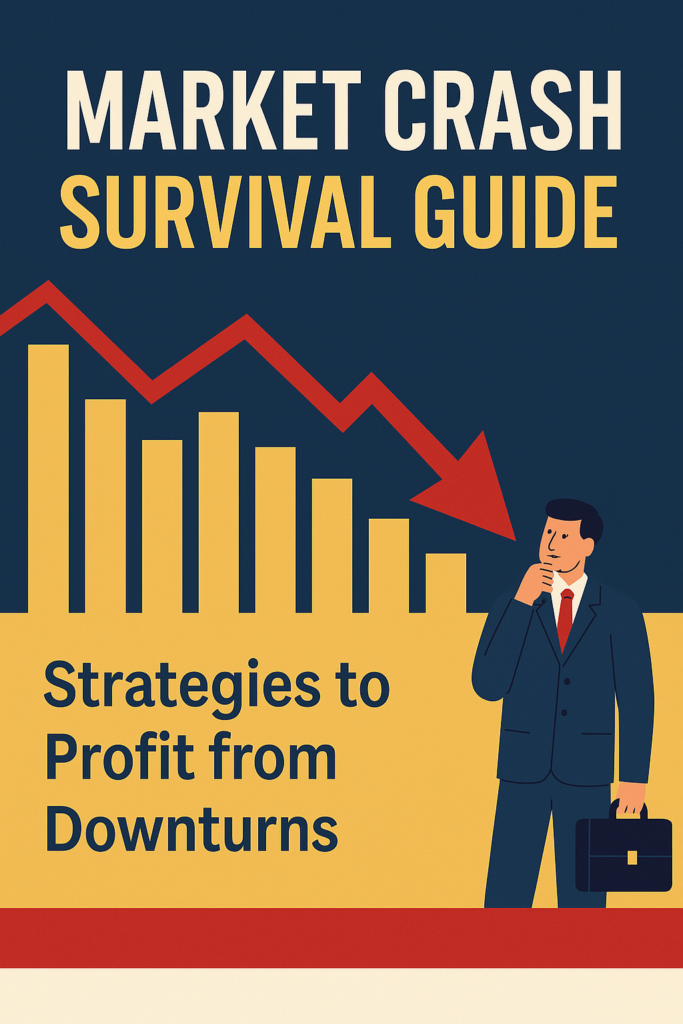Table of Contents
ToggleAre You Ready for the Next Market Crash? Here’s Market Crash Survival Guide
Stock market crashes are feared by most, but for smart investors, they are golden opportunities. The world’s greatest investors—Warren Buffett, Charlie Munger, and Rakesh Jhunjhunwala—made their fortunes by buying during market downturns. If you understand market cycles and apply the right strategies, you can turn every crash into a wealth-building moment.
Disclaimer
The information provided in this article is for educational purposes only and does not constitute financial or investment advice. Stock markets are subject to risks, and past performance does not guarantee future results. We strongly recommend conducting your own research or consulting with a financial advisor before making any investment decisions.
Understanding Market Cycles: Why Do Markets Crash?
The stock market follows a predictable pattern of booms and busts. Historically, crashes occur due to:
- Overvaluation & Market Bubbles – Dot-com bubble (2000), Housing bubble (2008)
- Interest Rate Hikes & Liquidity Crunch – 2022 Federal Reserve hikes crushing tech stocks
- Geopolitical Events – Russia-Ukraine war impacting global markets in 2022
- Financial Crises & Corporate Scandals – IL&FS (2018), Yes Bank crisis (2020)
- Black Swan Events (Unpredictable) – COVID-19 pandemic (2020)
Key Takeaway: Crashes happen regularly, but markets always recover.
Strategies of Billionaire Investors: Lessons from Buffett & Jhunjhunwala
Warren Buffett’s 3 Rules for Market Crashes:
Be Greedy When Others Are Fearful
- In 2008, Buffett invested in Goldman Sachs while others were panicking.
- Focus on Cash-Generating Businesses
- He prefers companies with strong free cash flow and minimal debt.
- Hold for the Long Term
- He never sells great companies during downturns (e.g., Apple, Coca-Cola).
Rakesh Jhunjhunwala’s Secret
- Bought Titan (Tata Group) in 2002, which turned into a 100x return investment.
- His mantra: “Buy strong brands in panic, hold for decades.”
Market Crash Playbook: What to Do Before, During, and After a Crash
1. Before the Crash: Preparation Phase
- Keep 20-30% cash reserves for big buying opportunities.
- Invest in debt-free, high ROE companies.
- Track economic indicators (FII selling, rising VIX, GDP slowdown).
- Create a Crisis Watchlist – Identify stocks to buy when markets fall.
2. During the Crash: Execution Phase
- Do not panic sell!
- Invest gradually (10%, 20%, 30%) as prices drop.
- Buy dividend-paying stocks for passive income.
- Look at historical patterns to time the bottom.
4. After the Crash: Recovery & Rally Phase
- Hold stocks for 5-10 years – biggest wealth is built after crashes.
- Reinvest dividends – accelerates portfolio recovery.
- Exit weak stocks and reinvest in strong companies.
- Ride the next bull run – Example: 2021 rally after the COVID crash.
How to Spot Companies That Will Go Bankrupt in a Crash
Red Flags That a Stock Will Go to Zero:
- Debt-to-Equity Ratio > 2.0 (High debt = bankruptcy risk)
- Promoters selling stake (Insiders know first)
- Negative cash flow for 2-3 years
- Borrowing money to pay dividends (Fake financials)
- Stock dilution (Company struggling to raise cash)
Recent Examples: DHFL, Yes Bank, Reliance Capital, Jet Airways
What to Do If You Hold a Failing Stock? Exit & reinvest in stronger companies.
Best Sectors to Invest in During a Market Crash
Certain sectors recover faster than others post-crash:
- Power & Utilities (NTPC, Tata Power, NHPC) – Essential services are always in demand.
- Banking & Financials (HDFC Bank, Kotak, SBI) – Strong recovery after crashes.
- Consumer Goods (HUL, ITC, Britannia) – People always need essentials.
- Pharma (Sun Pharma, Dr. Reddy’s, Cipla) – Healthcare demand never drops.
- Tech (TCS, Infosys, HCL Tech) – IT demand rebounds quickly.
Avoid: Highly leveraged companies, speculative stocks, and over-hyped sectors.
Avoiding Common Mistakes in Market Crashes
- Don’t invest all money at once – Use phased buying.
- Don’t invest in weak stocks – Check financial health first.
- Don’t exit too early – Hold for the full bull cycle.
- Don’t follow the crowd – Be a contrarian investor.
Stick to your investment plan, be patient, and focus on long-term wealth creation.
Frequently Asked Questions (FAQs)
1. Can We Predict When a Stock Market Crash Will Happen?
While it is impossible to predict the exact timing of a crash, investors can monitor warning signs such as:
- Rising inflation and interest rates.
- Excessive stock market valuations.
- High investor euphoria and FOMO.
- Global economic slowdowns or black swan events.
2. How Can You Profit from a Stock Market Crash?
- Buy fundamentally strong stocks at low prices.
- Invest in dividend stocks for steady income.
- Diversify into recession-proof sectors like utilities, pharma, and FMCG.
- Hold for 5-10 years to maximize returns.
Recommended Books for Deeper Learning
- The Intelligent Investor – Benjamin Graham
- The ultimate guide to value investing in crashes.
- Common Stocks and Uncommon Profits – Philip Fisher
- How to identify long-term wealth-building stocks.
- The Psychology of Money – Morgan Housel
- Master emotions & avoid panic-selling.
- Antifragile – Nassim Taleb
- How to turn uncertainty into advantage.
- Unshakeable – Tony Robbins
- A step-by-step plan to invest safely in any market.
Final Thoughts: How to Use This Knowledge for Maximum Profit
- Crashes create millionaires. If you buy strong stocks at low prices, your wealth multiplies.
- Identify strong businesses with low debt & high cash flow before investing.
- Stick to your investment plan & avoid emotional decisions.
- Understand market cycles & use them to your advantage.
Would you like a curated stock watchlist for the next crash? Subscribe to our newsletter and stay prepared!



